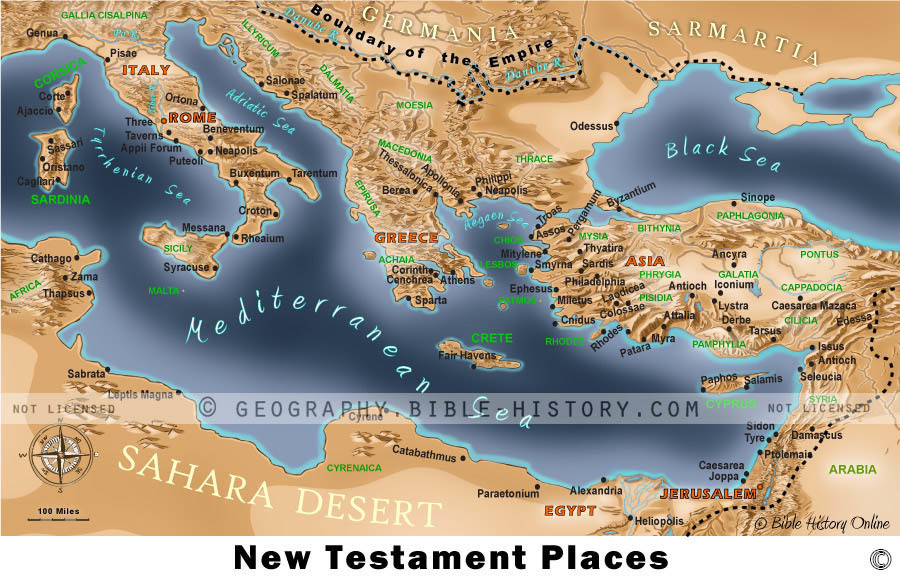
The map of New Testament places offers a captivating and immersive visual journey into the geographical locations that played a central role in the events and teachings of the New Testament. These places were not only settings for the unfolding of the Christian message but also bear witness to the profound impact of Jesus and his disciples on the ancient world. Here is a description of this historical map:
Geographical Scope:
This map provides a comprehensive view of the geographical locations mentioned in the New Testament, spanning regions in the eastern Mediterranean, including modern-day Israel, Palestine, Turkey, Greece, and beyond.
Key Cities and Landmarks:
The map prominently features cities and landmarks that are closely associated with the life and teachings of Jesus, as well as the activities of early Christian communities. It includes iconic places like Jerusalem, Bethlehem, Nazareth, Capernaum, and the Mount of Olives.
Religious Significance:
This map serves as a visual testament to the religious significance of these places in the Christian tradition. It highlights the locations where significant events from the New Testament took place, such as the birth of Jesus, his ministry in Galilee, and the Last Supper in Jerusalem.
Historical Context:
The map provides historical context for the New Testament places, reflecting the political, social, and cultural environments during the time of the Roman Empire. It also explores the diverse populations and religious beliefs in these regions.
Routes and Journeys:
It outlines the routes and journeys of Jesus, his disciples, and early Christian missionaries as they traveled from place to place, spreading the message of Christianity.
Cultural Insights:
Exploring the map allows viewers to gain insights into the culture, society, and daily life of the people living in these New Testament places. It offers a connection to the customs, traditions, and challenges faced by the early Christian communities.
Religious Communities:
The map may also indicate the locations of early Christian congregations, synagogues, and places of worship, shedding light on the growth of Christianity in these urban centers.
Archaeological Discoveries:
Incorporating markers or references to archaeological discoveries and excavations in these places can provide insights into the historical accuracy of New Testament accounts and the tangible evidence of early Christianity.
The map of New Testament places invites viewers to explore the geographic tapestry of the New Testament narrative. It allows them to delve into the geography, history, and cultural context of these iconic places, enriching their understanding of the events, teachings, and early Christian communities that were integral to the New Testament story.
Blank Topo Map of The World
Abraham’s Journey
The Captivity of Judah (586-516 B.C.)
The Fall of Judah 586 B.C.
The Northern Kingdom of Israel
The Southern Kingdom of Judah
The Divided Kingdom
The Fertile Crescent
Ur of the Chaldees
Shechem in Old Testament Times
Prophets, Kings, and Nations
Jesus Last Passover
New Testament Israel
New Testament Places
Old Testament Israel
Provinces of the Roman Empire
Israel during David’s Kingdom
David’s Kingdom
Cities of the New Testament 4
Cities of the New Testament 3
Cities of the New Testament 2
Mediterranean Sea
Cities of the New Testament
First Century Jerusalem
Empire of David and Solomon
David’s Kingdom
Israel Under Rehoboam
Ophir and Tarshish
The Period of the Kings
Ramoth Gilead
Samaria
Solomon’s Temple
Zarephath and MT Carmel
Jabesh Gilead and Tribes
Judah in the Time of David
Kingdom of Saul
Kirjath Jearim
Michmash
Mount Gilboa in the Time of David
Nob Davids Flight
Shiloh
Israel and Judah
Assyrian Empire Under Esarhaddon
Assyrian Empire Under Sennacherib
Captivity of 10 Tribes
Events in 2 Kings
The Khabur River
Israel and Syria
Captives From Judah
Kingdom of Jeroboam
Mesha’s Kingdom
Pharaoh Necho Battles King Josiah at Megiddo
Babylonian, Mede and Persian Empires
Samaria and Nearby Territories
Syria at its Height
Hebron
Mahanaim
1949 Map of Israel With Boundaries
First & Second Journeys of Paul
Journeys of the Apostles
Paul’s Third Missionary Journey
Saul’s Journey to Damascus and Arabia
Paul’s Final Visits
Paul’s 1st Missionary Journey
Paul’s 2nd Missionary Journey
Paul’s 3rd Missionary Journey
Paul’s Voyage to Rome
Phillip Journeys to Samaria and Gaza
Judah at the Time of Amos
Empire of Alexander the Great
Israel Under the Maccabees
Galilee During Maccabees
Idumea Intertestamental Period
Kingdom of the Ptolemies
Kingdom of the Seleucids
Ptolemaic Egypt Seleucid Asia
The Roman World
Kingdom of Ptolemies and Seleucids
The World During the 6TH Century BC
Mount Horeb
The Red Sea
The Exodus
Ezra’s Journey to Restore Jerusalem
Israel and Judah During Hosea’s Time
The Ancient World
Canaan During the Time of Abraham
The City of Shechem
Supposed Location of the Garden of Eden
The Land of Israel in Genesis
The Jordan River
The Kingdom of Nimrod
Mount Ararat and Mesopotamia
The Descendants
Sodom and Gomorrah
The Kingdom of Egypt
The Hamites
The Kingdom of the Hittites
Ur of the Chaldees
Judah at the Time of Haggai
Jesus Passes Through Samaria
